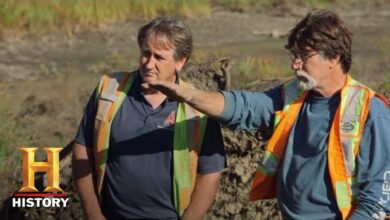What Fans Don’t Know About the Curse of Oak Island
What Fans Don't Know About the Curse of Oak Island

For over two centuries, Oak Island has held one of the world’s greatest unsolved mysteries.
An island cursed by death, secrecy, and obsession.
Legend says seven men must die before its hidden treasure will finally be revealed. So far, six already have.
But the real question isn’t just what’s buried there. It’s why so many have risked everything to find it.
From whispers of pirate gold to sacred relics of the Knights Templar, every clue leads deeper into a puzzle that defies logic.
And while millions have watched the curse of Oak Island unfold on TV, few realize just how much of the truth has never been shown.
Now, the story of Oak Island is one of mystery, danger, and obsession that’s lasted for centuries.
The so-called curse of Oak Island has been whispered about for over a hundred years, though nobody knows exactly where it began.
According to legend, seven men must die before the island’s ultimate treasure can finally be revealed. So far, six have already lost their lives searching, leaving just one more, if the curse is real, before the mystery supposedly ends.
What makes the legend so fascinating is that no one truly knows what the treasure even is.
Some believe it’s the long-lost loot of pirates like Captain Kid or Blackbeard.
Others think it could be ancient relics, perhaps the treasures of the Knights Templar, the Cathars, or even Marie Antoinette’s jewels.
Some theories get even wilder, suggesting Shakespeare’s manuscripts, lost Aztec gold, or Freemason artifacts lie hidden beneath the island.
The whole story began in the late 1700s. In 1795, three teenagers, Daniel McInness and his two friends, stumbled upon a strange depression in the ground.
When they started digging, they uncovered layers of logs and dirt that seemed man-made.
That hole would go on to be called the money pit, the beating heart of Oak Island’s legend.
Rumor has it that those same three friends mysteriously became wealthy later in life, leading some to wonder if they might have found the treasure and kept quiet about it.
Before their discovery, locals already told tales of hidden pirate gold buried somewhere on the island.
But the boys’ find gave those rumors new life.
Decades later, in 1857, McInness’s story was finally published, reigniting global curiosity about what might lie below.
The first organized dig didn’t happen until 1861 when a company called the Oak Island Association arrived with proper equipment.
Unfortunately, tragedy struck early.
A boiler explosion claimed a worker’s life, marking the first fatality tied to the island’s curse.
Over the next century, group after group tried their luck.
One of them, the old gold salvage group in 1909, included none other than a young Franklin Delano Roosevelt.
Long before becoming president, FDR was fascinated by the mystery and even helped fund digs.
He visited the island multiple times and almost financed another expedition just six years before his death in 1945.
Despite countless digs, no one has ever uncovered the legendary treasure.
Instead, Oak Island has taken five more lives, bringing the total to six.
The island’s structure makes exploration nearly impossible.
Flooding, sinkholes, and unstable tunnels constantly sabotage efforts.
Some researchers even believe the pit is protected by an elaborate system of traps designed to keep intruders out, like something straight from a movie.
Even so, small discoveries keep hope alive.
Excavators have found a 16th-century gemstone brooch, an old Spanish coin, fragments of wooden casks, and a 14th-century lead cross.
None of these finds prove a massive treasure exists, but they fueled the belief that something extraordinary still lies below.
Today, half of Oak Island is owned by Oak Island Tours and the Michigan Group, who run both the tourism and the hit television series, The Curse of Oak Island.
That’s where the modern story takes off with brothers Rick and Marty Lagina.
Their fascination started when Rick came across an article about Oak Island in an old Reader’s Digest magazine.
He showed it to Marty when they were kids, and the story of secret tunnels and booby-trap treasure stuck with them for life.
Years later, their father reignited that interest by showing them newspaper articles about the same mystery.
It became a family obsession, something they talked about for decades.
When the chance finally came to buy part of the island, the Lagina brothers didn’t hesitate.
They partnered with longtime treasure hunter Dan Blankenship, who already owned the other half, and together they began a new chapter in Oak Island’s long history.
Then in 2014, the History Channel premiered The Curse of Oak Island, following the Lagina Brothers on their relentless quest for answers.
Season after season, audiences have watched them chase clues, unearth mysteries, and put centuries-old legends to the test.
At the heart of it all lies the infamous money pit, a mysterious shaft said to hold everything from pirate treasure and ancient relics to even sacred biblical artifacts.
For more than a century, countless treasure hunters have tried to uncover its secrets.
But after so much digging, the land itself has turned against them.
The area has been flooded, collapsed, and filled with debris from earlier excavations.
Today, even with advanced technology, the Lagina brothers and their team only have a rough idea of where the original shaft truly is.
And every step they take brings them closer to danger on ground that’s unstable, unpredictable, and filled with history.
No matter how advanced their technology gets, the outcome almost always follows the same frustrating pattern.
As soon as they dig deep enough, water begins flooding the hole, forcing them to stop.
During an interview with Frank FM, Rick Lagina explained that this problem isn’t just about the tricky soil.
It’s also about history.
The money pit has been riddled with holes and tunnels from past searches, many of which were never properly documented.
That means the team is constantly trying to make sense of decades of chaotic digging layered on top of natural formations.
To get a clearer picture of what might really be happening underground, some experts have turned to science.
A retired geologist named Steven Atkin took a professional look at the theories surrounding Oak Island’s mysterious pits and tunnels.
Reviewing geological reports dating back to the 1960s, Atkin found that the bedrock beneath the supposed money pit area is mostly made up of limestone and gypsum.
Those materials are known to dissolve easily under the right conditions, creating natural sinkholes and cavities.
In other words, the mysterious tunnels and voids might not be man-made at all.
They could simply be the result of natural erosion.
Atkin was blunt about his conclusion, stating that there’s likely no treasure buried in the money pit.
Still, even with science weighing in, the island refuses to give up its secrets quietly.
Every new hole eventually fills with water.
But before that happens, some strange things have been found.
During one drilling operation, a core sample pulled up layers of metal, oak, and cement before hitting something solid—iron.
In other spots, underwater cameras have shown eerie images that look like bodies or even a classic treasure chest.
Divers have gone down hoping to confirm the discoveries, but nothing definitive has ever been recovered.
And that’s what keeps the mystery alive.
After all this time, the biggest question still hangs in the air.
Is there truly a treasure buried beneath Oak Island?
Or has the entire legend just been nature’s clever illusion all along?
Now, the truth is, nobody knows for sure.
What we do have, however, are countless theories, some rooted in history, others straight out of legend.
One of the most popular theories, according to Sky History, is that the hidden treasure once belonged to the 17th-century pirate Captain Kid.
Historians have chased his trail for years and even uncovered some of his loot, including a massive 121-lb silver bar off the coast of Madagascar, as reported by Smithsonian magazine.
But many believe that was just a small piece of the puzzle and that the rest of his fortune could still be buried somewhere on Oak Island.
This theory gained serious momentum back in the 1800s when workers unearthed a mysterious stone tablet.
Its cryptic message allegedly read, “40 ft below, 2 million pounds lie buried.”
That discovery ignited imaginations everywhere, convincing many that a pirate’s fortune worth millions might be waiting underground.
Of course, that’s just one version of the story.
Some believe the treasure could be from a sunken Spanish galleon packed with gold, a lost Viking ship, or even gold hidden by British soldiers to keep it out of the hands of American revolutionaries.
These theories might sound far-fetched, but they’re not impossible.
Pirates did stash valuables on remote islands, and countless ships were lost to the sea.
Then come the wild theories, the ones that stretch beyond reason but keep the legend alive.
Some suggest that Oak Island hides Shakespeare’s original manuscripts, while others claim it’s the resting place of the Knights Templar’s most sacred relics, the Holy Grail, and the Ark of the Covenant.
And that’s where the story takes a sharp turn.
One theory that’s made waves on Reddit dives into conspiracy territory.
A user known as Mdinus Legendarius proposed an unusual idea.
What if someone on the treasure hunting team is deliberately leading them astray?
A mole working to make sure the treasure is never found.
Their theory centers on Charles Barkhouse, the island’s historian and longtime cast member.
For anyone who’s watched since season 1, Charles is known as a walking archive of Oak Island’s history and folklore.
His insight has guided Rick and Marty Lagina through countless discoveries.
But according to this Reddit theory, that’s exactly why he’s so suspicious.
Fans have pointed out that Charles tends to stay vague during discussions, offering little commitment to specific theories, especially when it comes to anything involving the Knights Templar or Freemasons.
Some think his calm, agreeable demeanor hides a deeper secret, suggesting he might even be part of a Masonic group with hidden motives.
This idea isn’t new.
In earlier discussions, fans speculated that Charles might be a secret Templar, intentionally throwing the team off course.
One viewer even commented that it often feels like he knows more than he’s letting on.
It’s a fun theory, but also one that raises a lot of eyebrows.
When the debate resurfaced, other fans stepped in to debunk it.
One user who identified as a Freemason named Adeneco broke down why the theory doesn’t hold up.
They explained that Freemasonry doesn’t operate as one global organization.
It’s made up of independent jurisdictions.
So, the idea of a worldwide Masonic plot connected to Oak Island doesn’t really make sense.
They also added that the supposed link between the modern Masons and the Medieval Knights Templar is mostly speculation with no strong historical proof to back it up.
Another Mason in the thread supported this using a clever analogy.
Claiming a connection between the two is like saying there’s a link between the pirate Captain Kid and the Pittsburgh Pirates baseball team.
Even with all that logic, not everyone was ready to let go of the mole theory.
For some, the mystery of Oak Island is too deep and too strange to dismiss so easily.
That’s when another fan threw out a new name, Paul Troutman, the head of the island’s research center.
They argued that his position would make it easy to control what information is revealed or hidden from the rest of the team.
And just like that, the conversation took another turn.
But among all the theories about Oak Island, one stands out for how detailed and oddly believable it is.
It’s known as the William Fipps theory, introduced by author Hammerson Peters in the Oak Island Encyclopedia.
This theory takes the story all the way back to the 1600s.
William Fipps was a real historical figure, an explorer and treasure hunter who struck gold literally when he discovered the wreck of the Spanish Galleon Conception.
When he returned to England, he brought back an enormous fortune worth millions in today’s money.
But according to the story, that was only the beginning.
Rogue Protestant allies, secretly supported by King William III of the Netherlands, urged Fipps to go back and recover even more treasure.
Their plan was to use the riches to help fund an uprising against the Catholic King James II.
So Fipps supposedly returned to the wreck, recovered more treasure, and shared much of it with his Protestant backers.
But like anyone who stumbles across a massive haul, he decided to keep a portion for himself.
And legend says he hid it somewhere secret.
That place, according to the theory, was Oak Island.
This could explain the creation of the island’s legendary money pit.
As the story goes, while Fipps and his men were burying their treasure, their pit began to flood.
They tried again and again to recover what they’d buried, but nature had other plans.
Eventually, the treasure and its location were lost.
Writer Randall Sullivan adds another layer to this tale.
He suggests that when the British crown realized what Fipps had done, they decided that if they couldn’t have the treasure, no one could.
To make sure of that, they allegedly booby-trapped the island, engineering the flood tunnels and false shafts that continue to frustrate treasure hunters to this day.
What makes this theory especially intriguing is that modern evidence seems to line up with parts of it.
Excavations have uncovered 17th-century English tools, traces of human activity from that exact period, and even human bones dating back to the same era.
All of it could support the idea that Fipps or someone like him was there centuries ago.
If that’s true, then the Oak Island mystery may have started with one man’s secret stash of silver and a failed attempt to dig it back up.
Of course, the big question remains.
Is Oak Island’s mystery real or just one of the longest-running hoaxes in history?
That debate has consumed treasure hunters, historians, and fans for generations.
The search has cost people fortunes, years of their lives, and even their safety—all for a treasure that might not exist.
Which brings everything back to the men leading the hunt today, the Lagina brothers.
According to TV Overmind, they’ve been asked point-blank if they ever worry that their massive Oak Island operation could turn out to be a total waste of time and money.
Marty Lagina admitted that the thought crosses their minds sometimes, but he insists their belief in the mystery’s truth keeps them going.
Rick Lagina went even further, revealing they don’t have a backup plan if the treasure turns out to be a myth.
They’ve gone all in, driven by conviction rather than caution.
That unwavering faith might be the very thing keeping the entire search alive.
But here’s what makes the curse of Oak Island so fascinating.
Even after all these years, with no treasure in sight, the team keeps unearthing remarkable artifacts.
Every find adds a new piece to the puzzle, hinting that something extraordinary really did take place on that island centuries ago.
Among the countless theories trying to explain these discoveries, one of the most intriguing comes from an online researcher who connected Oak Island’s mystery to a Portuguese explorer from the early 1500s, Gaspar Corte-Real.
This theory, posted on Reddit by a user named Yugwal, is surprisingly detailed and backed by historical sources.
It suggests that Corte-Real’s disappearance during a voyage to Newfoundland in 1501 might be directly linked to the origins of the Oak Island legend.
Here’s how the story goes.
Corte-Real set sail with a fleet of ships, but only two of them made it back home.
His own vessel and everyone on board vanished without a trace.
The ships that returned brought back maps of the Canadian coastline.
But here’s the strange part: those maps didn’t actually match any known part of Newfoundland.
Instead, the coastal outlines looked much more like Nova Scotia, where Oak Island sits today.
That detail opens up a whole new possibility.
If Corte-Real and his crew drifted farther south than planned, they could have ended up on Oak Island itself.
Maybe they set up camp there trying to survive after being stranded.
And if they carried valuables, royal possessions, or important documents from Portugal, it would make sense that they’d want to hide them somewhere secure.
That could very well be the origin of the island’s infamous money pit.
This theory fits perfectly with what’s been uncovered so far.
The artifacts found on the island—old coins, tools, and relics—carry a distinctly European touch, all dating back to the same era.
So, even if the treasure itself remains hidden, the evidence might be pointing to something far more profound.
The forgotten tale of an early European expedition that left its mark on Nova Scotia long before the legend took shape.
But here’s the strange part.
Despite satellites, sonar, and all the latest technology, you’d think finding the Oak Island treasure would be simple by now.
Yet, after decades of experts and endless digging, there’s still no solid proof that any treasure exists at all.
So, what’s really stopping them?
Some believe the answer lies in one chilling idea, the Oak Island curse.
The curse itself is simple, but dark.
Legend says that as long as people keep coming to the island searching for treasure, seven men must die before the hidden riches will finally reveal themselves.
It sounds like something straight out of a movie, but this eerie story has been around for generations, passed down in books, whispered about on TV, and debated endlessly online.
No one can even trace where it began.
What makes it even creepier is that six people have already lost their lives on the island.
The first tragedy struck in 1861 when a boiler explosion killed an unnamed worker during an excavation.
Decades later, in 1897, another man fell to his death after slipping from a rope.
Then in 1965, four workers, including a father and son, were overcome by toxic fumes and drowned inside one of the pits.
If the curse holds true, one more life must be claimed before the treasure is ever found.
When brothers Rick and Marty Lagina began their televised treasure hunt, they weren’t just exploring history.
They were stepping into a legend.
In an interview with radio host Neil Haley, they talked about how their lifelong fascination with Oak Island eventually turned into a reality series and how the idea of the curse has always lingered in the background of their work.
Rick explained that the curse is said to involve both the island’s oak trees and human lives.
Seven searchers must die before the treasure will allow itself to be found.
Even though neither brother fully believes in the curse, they admit it’s hard to completely ignore.
As Rick put it, “The rational mind might dismiss it, but a more instinctive part of you still feels uneasy about tempting fate.”
Marty agreed, admitting that luck, good or bad, is something they always think about when they’re out there digging.
Regardless of superstition, the brothers say they won’t stop searching.
Curse or no curse, their goal is to uncover the truth behind Oak Island once and for all.
Interestingly, the “seven must die” version of the story only gained traction in the last 100 years.
Some reports claim as many as 14 people have died searching for the treasure, but the show itself sticks to the number six.
And despite the curse being front and center in the show’s title, it’s not actually a major focus in most episodes.
This has sparked plenty of debate among fans.
Many online discussions point out how odd it is that something so central to the show’s premise is barely mentioned.
One viewer summed it up by saying, “The curse gets hyped up in the intro, yet rarely comes up during the episodes.”
Some think it’s intentional.
After all, constantly reminding the crew that someone has to die wouldn’t exactly boost morale.
Others believe the curse’s vague origins make it too flimsy to explore deeply on air.
Still, even with its limited role, the curse remains one of the most haunting and talked-about aspects of the Oak Island mystery.
Whether it’s real or not, its shadow looms over every dig, every theory, and every new discovery.
And until that seventh death or the treasure itself finally surfaces, the legend of the Oak Island curse isn’t going anywhere.








